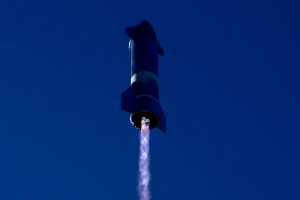While running behind schedule in classic fashion, SpaceX CEO Elon Musk says he’ll present the first big Starship program update in two and a half years on Thursday, February 10th.
Additionally, as an apparent centerpiece for the event and update, Musk says that SpaceX will perform the second-ever “full stack” fit test with a Starship upper stage and Super Heavy booster.
Starship S20 and Super Heavy booster B4 were stacked for the first time in early August 2021, when both stages were still weeks or even months away from some degree of completion. Only months later did Starship S20 kick off a multi-month period of qualification tests, eventually becoming the first Starship prototype to successfully test a full six Raptor engines at once. Super Heavy B4, on the other hand, had an even more painful time for unknown reasons and only graduated to basic cryogenic proof testing in mid-December – more than four months later.
While the booster has had a full 29 Raptor 1 engines installed for months, the booster has yet to perform or attempt a single static fire of any number of those engines and hasn’t even managed a basic wet dress rehearsal with real liquid oxygen and methane propellant. Eventually, SpaceX did perform a handful of Booster 4 Raptor ignition tests, but those were almost more of a test of the launch pad than Super Heavy itself. The slow and minimal progress SpaceX has made testing Super Heavy B4 may actually be because of issues with orbital launch pad’s tank farm design. To this day, while the oxygen and nitrogen half of the farm are already storing thousands of tons of propellant and coolant, the fuel side of the same farm has yet to be filled with any methane. That makes thoroughly testing a Super Heavy booster much harder, though there are some obvious workarounds SpaceX could have made if it had really wanted to start proof testing Booster 4 as soon as possible.
In fact, it’s no longer clear if Ship 20 and Booster 4 will actually get to fulfill their original goal of supporting Starship’s first orbital (velocity) test flight. Nonetheless, they are still two giant, nearly completed stages that together form a full Starship ‘stack.’
Heading into 2022, SpaceX appears to be more focused on testing a somewhat extraneous part of the first orbital Starship launch site – “chopstick” arms installed on the launch tower. SpaceX’s current Starship ‘launch tower’ design centers around the need for three giant swinging arms – one to fuel and power Starship and the other two to lift, stack, and – maybe one day – catch Super Heavy boosters and ships. Had SpaceX stayed true to the original Starship/BFR/ITS design, the booster would have been fueled through the launch mount and Starship would have been fueled through a connection with the booster, significantly simplifying the tower.
In theory, replacing that design with a complex, building-sized umbilical arm might ultimately improve Starship’s nominal payload to orbit by a few percent. Additionally, using the even more complex “chopsticks” – a pair of giant arms – to lift and stack Super Heavy and Starship may actually be a smart design, as it could theoretically free SpaceX from the painful operational constraints imposed by large cranes.
By all appearances, that’s exactly what SpaceX plans to test next week. Starship S20 has already been moved adjacent to the launch tower and Super Heavy B4 has been attached to a crane (somewhat ironically) in preparation for its own move to the tower. For the first time, SpaceX might use the tower arms to lift Super Heavy onto the orbital launch mount, stabilize the booster, and then lift and stack Starship on top of it – all without a crane, in theory. Of course, insofar as SpaceX performed the first full-stack fit test with a crane, the tower’s lift/catch arms only really become irreplaceable once waiting a few days for safe lift conditions becomes a bottleneck for Starship launch operations.
Nonetheless, a successful stacking operation with those arms would be an impressive technical feat and demonstrate one of the things needed for all-weather Starship launch operations, even if it won’t leave SpaceX any closer to orbital test flights than it was before.





